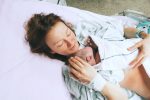Most Parents Surveyed in Japan Support SMA Newborn Screening

Despite being mostly unaware of spinal muscular atrophy (SMA), most Japanese parents support newborn screening for the disease, according to data from a small survey-based study.
The most cited reasons behind this support included the importance of early diagnosis and the fact that treatments are available.
These findings add to the growing number of studies and efforts supporting the benefits of newborn screening for SMA, as well as its implementation around the world.
Still, there is a need to collect more data to determine appropriate treatment for every possible situation and to build a robust follow-up system before the screening is implemented in the country, the researchers noted.
The study, “Views of the General Population on Newborn Screening for Spinal Muscular Atrophy in Japan,” was published in the journal Children.
The leading genetic cause of death in infants and children, SMA affects 1 in every 6,000 to 10,000 live births. It is caused by a deficiency of SMN — a protein essential for motor neuron and muscle health — mainly due to mutations in both copies of the SMN1 gene.
The existence of a second SMN gene, called SMN2, partly compensates for the loss of SMN1-produced SMN. Typically, the more SMN2 gene copies a person has, the less severe the disease.
The approval of the first SMA treatment — Biogen’s Spinraza (nusinersen) — in 2016 and 2017 in several countries and the importance of early detection and treatment in preventing lifelong disability prompted the start of newborn screening programs for SMA in a number of countries.
In Japan, SMA has not yet been added to the list of diseases screened in newborns, but a pilot screening study was conducted in 2018 and 2019.
Now, researchers have assessed how the general parental population in Japan views newborn screening for SMA.
An explanation sheet and a questionnaire about SMA newborn screening were distributed to two general population groups. One group included 106 parents of children visiting an allergy clinic, and the other included 235 parents of 5-year-olds visiting the hospital for a medical check-up.
A separate group of eight parents of children with SMA also responded to the survey.
In the general population group, valid responses were obtained from 269 parents: 100 (94.3%) in the allergy group and 169 (71.9%) in the medical check-up group. Most respondents were mothers (94.4%) and 30 to 39 years of age (62.5%). Two participants reported being close to an SMA patient.
Results showed that about half of respondents said they knew nothing about SMA before the survey, with more than 45% reporting that they know a little about the disease, and less than 5% saying they knew a lot. In addition, more than 94% admitted to being unaware of new SMA treatments.
More than 95% of participants said they would prefer that their newborn be screened for SMA if such a program was available, mainly due to the importance of early diagnosis and the availability of disease-modifying treatments.
The main reason cited by the 10 parents who did not favor newborn screening for SMA was that they believed testing should be performed only after symptoms appear (five responses), followed by the fact that such screening would make them feel anxious (two responses).
When asked about how much they were willing to pay for SMA newborn screening, about 30% of all respondents said “any price,” another 30% were willing to pay about 5,000 yen (about $45), and less than one-quarter said they would only do it if it was free.
These responses were similar to those of parents of SMA patients treated with Spinraza. In that group, all parents favored SMA newborn screening, mainly citing early diagnosis as a key step to slow disease progression, and the fact that treatments are available.
In contrast to parents of children not affected by SMA, most parents of SMA patients would do the screening regardless of the price (62.5%), while 37.5% said they were willing to pay about 10,000 yen (about $91).
These findings highlighted that “the general population in Japan mostly agreed with screening for SMA in newborns even though they did not know much about SMA,” the researchers wrote.
As such, “we need to increase public awareness of SMA” and “accumulate more data to determine appropriate treatment indications” before implementing a newborn screening program for SMA, the team added.
One of the points still under debate is the management and treatment of newborns genetically diagnosed with SMA and carrying four or more SMN2 copies, who may likely develop milder forms of the disease, with an onset during childhood (type 3) or early adulthood (type 4).
To have a positive impact on SMA patients and their families, “[w]hen SMA newborn screening is performed, there should ideally be an established flow of treatment, a long-term follow-up system, support for the family, and a subsidy for medical expenses already in place,” the researchers wrote.
“Newborn screening for SMA is promising, but it is in very early stages,” they concluded.
The post Most Parents Surveyed in Japan Support SMA Newborn Screening appeared first on SMA News Today.





